 |
South West USA | Deel 4 |
Saturday, May 23, 2015
After breakfast
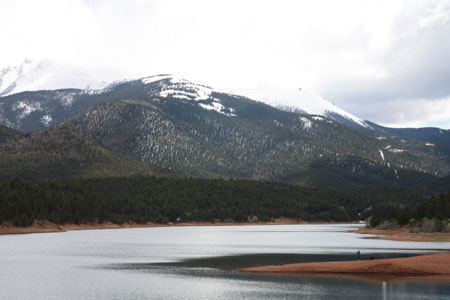 we
have coffee at Coffee Pablo before we drive to Colorado Springs. It is a
short drive, just over an hour to get there. The receptionist at the
Hyatt House
hotel is quite overbearing. The room is not ready yet. We can call at
noon to ask if we can come. It is located in a suburb of Colorado Springs,
near the Air Force Academy. Nearby are many training facilities for American
athletes. Because Colorado Springs is located at high altitude (1.839m) and
has good facilities, it is ideal for altitude training. The US Olympic
Committee also has a sports center. On the advice of the receptionist
Christiane drive to Old Colorado City. That is a historic area of Colorado
Springs. Colorado Town was founded in 1859 during the Colorado Gold Rush and
for five days it was even the capital of Colorado Territory. Now there is a
street festival on the occasion of Memorial Day. On that day (or rather
weekend) America’s war dead are commemorated on the 3rd Monday in May.
Monday is for many one of the few days off work in the year. It is crowded
and the attractions
we
have coffee at Coffee Pablo before we drive to Colorado Springs. It is a
short drive, just over an hour to get there. The receptionist at the
Hyatt House
hotel is quite overbearing. The room is not ready yet. We can call at
noon to ask if we can come. It is located in a suburb of Colorado Springs,
near the Air Force Academy. Nearby are many training facilities for American
athletes. Because Colorado Springs is located at high altitude (1.839m) and
has good facilities, it is ideal for altitude training. The US Olympic
Committee also has a sports center. On the advice of the receptionist
Christiane drive to Old Colorado City. That is a historic area of Colorado
Springs. Colorado Town was founded in 1859 during the Colorado Gold Rush and
for five days it was even the capital of Colorado Territory. Now there is a
street festival on the occasion of Memorial Day. On that day (or rather
weekend) America’s war dead are commemorated on the 3rd Monday in May.
Monday is for many one of the few days off work in the year. It is crowded
and the attractions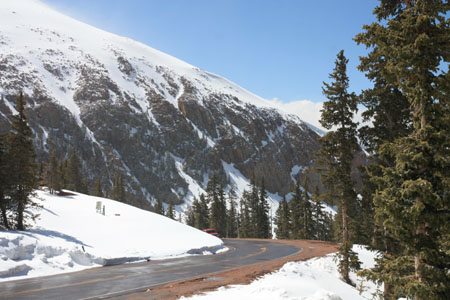 are quite loud. We do not stay long. We are off to the
Garden of the Gods. That
is a small nature reserve, which came about as a bequest managed by the
city. It is also very busy. There are traffic jams in the park. The visitor
center is also overcrowded. Moreover, a hail storm starts pouring down. We
call the hotel if the room is already available. And yes, that is the case.
Erik picks up some food and have lunch in our very spacious room. There is
even a kitchenette, a lounge and a dining table.
are quite loud. We do not stay long. We are off to the
Garden of the Gods. That
is a small nature reserve, which came about as a bequest managed by the
city. It is also very busy. There are traffic jams in the park. The visitor
center is also overcrowded. Moreover, a hail storm starts pouring down. We
call the hotel if the room is already available. And yes, that is the case.
Erik picks up some food and have lunch in our very spacious room. There is
even a kitchenette, a lounge and a dining table.
After lunch we decide to go to Pike’s Peak. The weather forecasts are mixed. We drive off under a sunny sky, but soon it starts raining. At the entrance of the road to the top staff alert us for the bad weather. The man at the desk advises not to drive further than the reservoir. Once there, the wind blows hard and it is snowing. We want to go back, but change our minds. We wait for a bit and it clears up and immediately the sun breaks through. We continue towards the top and it gets better still. We drive beyond the snow line and the scenery is gorgeous. We can not drive all the way to the top at over 4.700m, but our perseverance is rewarded with beautiful views.
We drive back to the hotel. At night we eat at a Mexican restaurant in the neighborhood.
Weather: rain, hail and snow, but also sunny spells. Around 12 °C (54ºF) but on the mountain around freezing point.
Sunday 24 May 2015
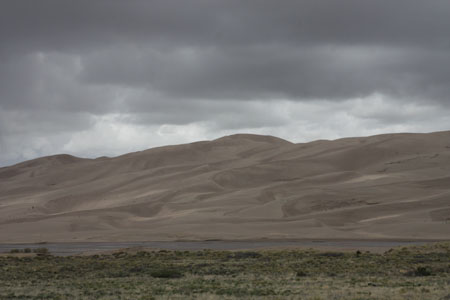 fine
and with many options. Starbucks coffee is available. We drive in a
southerly direction and continue on I-25. In Walsemburg we leave the
interstate and follow state highways to Great
Sand Dunes national Park & Preserve. This is a
peculiar National Park. Against the backdrop of the Rocky Mountains are
some huge sand dunes that would not look out of place in Morocco. This
sand was moved this way by the wind from the dry river bed of the Rio
Grande, until it could not go any further. The dunes are surrounded by
wetlands and are still growing and are up to 200 meters high. It's very
cold and there is a strong wind. Most visitors wade barefoot through the
Medano Creek to reach the foot of the Dunes and climb up there. We do
not.
fine
and with many options. Starbucks coffee is available. We drive in a
southerly direction and continue on I-25. In Walsemburg we leave the
interstate and follow state highways to Great
Sand Dunes national Park & Preserve. This is a
peculiar National Park. Against the backdrop of the Rocky Mountains are
some huge sand dunes that would not look out of place in Morocco. This
sand was moved this way by the wind from the dry river bed of the Rio
Grande, until it could not go any further. The dunes are surrounded by
wetlands and are still growing and are up to 200 meters high. It's very
cold and there is a strong wind. Most visitors wade barefoot through the
Medano Creek to reach the foot of the Dunes and climb up there. We do
not.
We drive back, eat in a simple road side diner and continue our trip to
New Mexico. Around 2:15pm we arrive in Taos. It's very busy here. Taos
is a small artists colony with homes built in Adobe Style. Unfortunately
it is very busy, because of the Memorial Day weekend.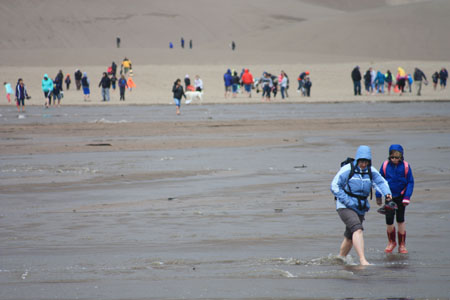 We stay at the
Historic Taos Inn. The
reception staff is extremely friendly. It is a complex of rooms arranged
around courtyards. We have a junior suite, which is spacious.. We have
two bathrooms and a fireplace. We walk around the village, have a coffee
at Tazza Espresso and buy some groceries at
Smith’s. We take a break and at 6pm we eat at the hotel
restaurant.
We stay at the
Historic Taos Inn. The
reception staff is extremely friendly. It is a complex of rooms arranged
around courtyards. We have a junior suite, which is spacious.. We have
two bathrooms and a fireplace. We walk around the village, have a coffee
at Tazza Espresso and buy some groceries at
Smith’s. We take a break and at 6pm we eat at the hotel
restaurant.
The food at
Doc Martin’s, the
restaurant in our hotel is fine. The server friendly and helpful. Later
in the evening we drink a cocktail in the cozy Adobe Bar, where
listening to live music.
Weather: sunny, occasional showers. 12°C (54ºF)
Maandag 25 May 2015
Monday, May 25 2015
To our surprise the Taos Inn serves no real breakfast. There is coffee
and tea to go and you can order a bagel - breakfast to go -
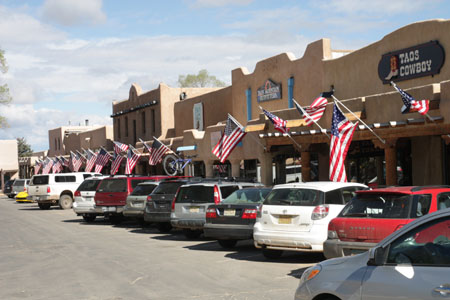 but
we really can not have breakfast. Advice for an alternative is not
given. We walk into the village and give it a try at the La Fonda Hotel
on the main square. Again, no breakfast, but we are referred to the
Taos Diner, about 500 meters
away. There we get a very American breakfast. Almost everything has egg
in it, but I manage to get something without. Erik takes the
Southwestern breakfast with green peppers. Very spicy.
but
we really can not have breakfast. Advice for an alternative is not
given. We walk into the village and give it a try at the La Fonda Hotel
on the main square. Again, no breakfast, but we are referred to the
Taos Diner, about 500 meters
away. There we get a very American breakfast. Almost everything has egg
in it, but I manage to get something without. Erik takes the
Southwestern breakfast with green peppers. Very spicy.
After breakfast we explore Taos. There are a number of historic houses.
For example
Kit Carson’s,
the legionnaire who fought the Navajos. A museum dedicated to the artist
Blumenschein,
who ended up here in 1898 along with his fellow artist Phillips, because
they had a broken wagon wheel while they were on their way to Mexico.
She never got round to leave. In 1915 they founded the
Taos
Society of Artists, which this year celebrates its centenary.
Many artists followed and Taos became 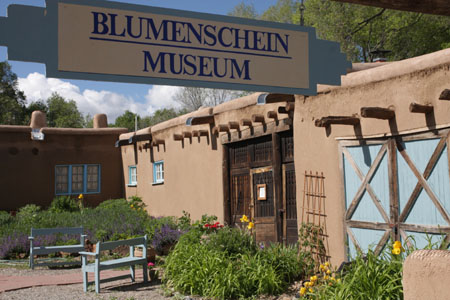 an
art colony. There are a lot of galleries that sell local art, but also
art by new arrivals. In addition, a lot of Native American art.
Unfortunately, most, if not all museums closed on Memorial Day. The same
goes for the Governor Brent house. Here, the first governor of the US
government was assassinated in 1837 by an angry mob of Pueblo and
Spanish. His family tried to escape, was caught, but spared. The
Taos Art museum is the
former residence of the Russian artist Fechin, but unfortunately also
closed. We decide to go to
Taos Pueblo
. This is a small reserve for the Pueblo Indians of Taos. This community
is one of the few Pueblo people, who were not evicted from their lands
by the Spaniards in the 17th century. The old part, with the original
Adobe complex is now home to 10 families who live here without
electricity, running water and heating. Around 3,000 Indians live close
by with the all modern conveniences. We get a tour by a young woman, a
freshman nursing student who hopes to work in the community in the
future.
an
art colony. There are a lot of galleries that sell local art, but also
art by new arrivals. In addition, a lot of Native American art.
Unfortunately, most, if not all museums closed on Memorial Day. The same
goes for the Governor Brent house. Here, the first governor of the US
government was assassinated in 1837 by an angry mob of Pueblo and
Spanish. His family tried to escape, was caught, but spared. The
Taos Art museum is the
former residence of the Russian artist Fechin, but unfortunately also
closed. We decide to go to
Taos Pueblo
. This is a small reserve for the Pueblo Indians of Taos. This community
is one of the few Pueblo people, who were not evicted from their lands
by the Spaniards in the 17th century. The old part, with the original
Adobe complex is now home to 10 families who live here without
electricity, running water and heating. Around 3,000 Indians live close
by with the all modern conveniences. We get a tour by a young woman, a
freshman nursing student who hopes to work in the community in the
future.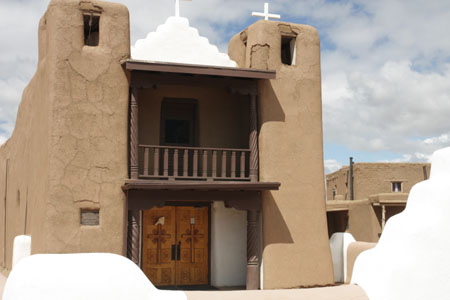 The tour is free but tips are very welcome. We start in the church,
which is on the World Heritage List. It was built after the uprising of
1837, in which the governor was killed. The US military then destroyed
the old church. The church is in use and the Indians share the priest
with the Catholic Church of Taos. The ruins of the original church are
still there, near the cemetery. We also see the clay ovens the Indians
traditionally make their fried bread in. The large multi-layered complex
was originally only and accessible via the ceilings by means of
ladders.. This for defensive reasons. With the arrival of the Spaniards
in the 16th century doors on the ground floor became more common. They
are painted blue or red. Blue doors invite and welcome the friendly
ghosts, the red to chase away the evil spirits. The residents choose the
color. There are a lot of shops selling Indian artifacts, jewelery and
utensils. In the middle of the square a ceremony takes place in
connection with Memorial Day. The fallen tribe members are commemorated.
Many Indians serve or have served in the
The tour is free but tips are very welcome. We start in the church,
which is on the World Heritage List. It was built after the uprising of
1837, in which the governor was killed. The US military then destroyed
the old church. The church is in use and the Indians share the priest
with the Catholic Church of Taos. The ruins of the original church are
still there, near the cemetery. We also see the clay ovens the Indians
traditionally make their fried bread in. The large multi-layered complex
was originally only and accessible via the ceilings by means of
ladders.. This for defensive reasons. With the arrival of the Spaniards
in the 16th century doors on the ground floor became more common. They
are painted blue or red. Blue doors invite and welcome the friendly
ghosts, the red to chase away the evil spirits. The residents choose the
color. There are a lot of shops selling Indian artifacts, jewelery and
utensils. In the middle of the square a ceremony takes place in
connection with Memorial Day. The fallen tribe members are commemorated.
Many Indians serve or have served in the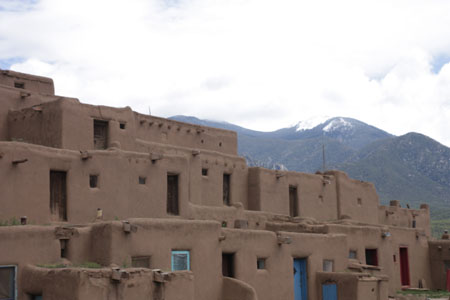 US Armed Forces in various wars. Up to the present day.
US Armed Forces in various wars. Up to the present day.
We then set off to drive the Enchanted Circle.
That is a route around Taos. The first stage is to the
DH Lawrence Ranch. The
British writer stayed a number of years in Taos in the 1920s. His widow
had him buried here. The farm and the grave are managed by the
University of New Mexico and is located about 5 miles from the highway
522 and is accessible via a dirt road. The signage is poor. We find it
using Google Maps. When we get it sadly turns out to be closed, (open
Thu-Sat). We continue our route to Red River, a ski resort. We have
lunch in a diner. During lunch it starts to hail hard. We drive through
beautiful landscapes, past Angel Fire and back to Taos.
At night we eat at Lambert’s Restaurant.
The receptionist speaks Dutch and is married to Thijs our waiter, who
comes from Enschedé and has lived for five years in our home town
Rotterdam. The food is of good quality but pricey.
Weather: sunny, but also a few showers. Even hail. Temperature around
15°C (59ºF).
Tuesday 26 May 2015
We 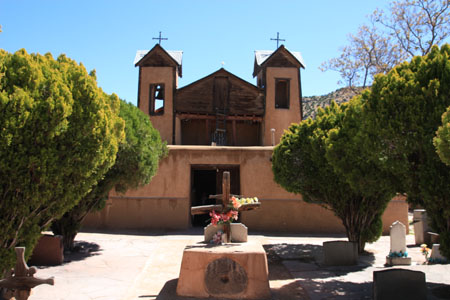 have
breakfast at the Taos diner. After that we drive to Santa Fe via the
High Road
. This is an official Scenic
Byway. We pass through villages like Las Truchas - known for the
movie
Milagro Bean Field War
directed by Robert Redford in 1988 - and Chimayo - known for weaving and
carpets. Las Truchas is at very high elevation and offers beautiful
views of the Truchas Peaks, the highest peaks of New Mexico. In Chimayo
we visit the Santuario de Chimayo. It is considered to be one of the
finest examples of an Adobe church in New Mexico. The church dates back
to 1816. At the back of the church is a small room with a well, the
source of the sacred mud that is supposed to have a healing effect.
Every year 30,000 pilgrims come here to ask for a wish come true or get
a blessing. Many come on foot, some even from Albuquerque. They also
take some mud with them. In days past, some even did eat it! Chimayo is
therefor known as America's Lourdes.
have
breakfast at the Taos diner. After that we drive to Santa Fe via the
High Road
. This is an official Scenic
Byway. We pass through villages like Las Truchas - known for the
movie
Milagro Bean Field War
directed by Robert Redford in 1988 - and Chimayo - known for weaving and
carpets. Las Truchas is at very high elevation and offers beautiful
views of the Truchas Peaks, the highest peaks of New Mexico. In Chimayo
we visit the Santuario de Chimayo. It is considered to be one of the
finest examples of an Adobe church in New Mexico. The church dates back
to 1816. At the back of the church is a small room with a well, the
source of the sacred mud that is supposed to have a healing effect.
Every year 30,000 pilgrims come here to ask for a wish come true or get
a blessing. Many come on foot, some even from Albuquerque. They also
take some mud with them. In days past, some even did eat it! Chimayo is
therefor known as America's Lourdes.
We drive to Santa Fe. In Santa Fe we stay at the
El Rey Inn, a large
motel with swimming pool, sauna and hot tub on Cerrillos Road. We 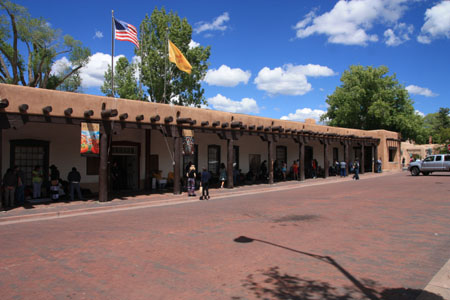 take
a break and then go to the Railyard,
a redeveloped railway yard. There are restaurants, shops and art
galleries. We eat there at the Junction
and shop at
REI. The area's set up is too wide and feels lifeless. We drive
into town and park near the Plaza. We drink coffee at Starbucks and walk
to the Plaza. Here is the 17th century
Palace of the
Governors, the former governor palace under Spanish, the Mexican
and American rule. During the Pueblo revolt of 1610, the Indians
took possession, but soon the Spaniards came back. Lew Wallace wrote
the novel Ben Hur here in 1880, when he was governor of New Mexico. Now
the palace is a historical museum. Also on the square is the
La Fonda hotel from
1922, built in Pueblo Revival style. Kit Carson stayed the night here
and so did John F. Kennedy. It's a beautiful building. We walk on to the
St Francis Cathedral, which was built here in 1886 by the Bishop Lamy,
who was of French origin. He was the first bishop here, after Santa Fe
had seceded from the Mexican diocese of Durango. The Romanesque French
Revival style building disagree
take
a break and then go to the Railyard,
a redeveloped railway yard. There are restaurants, shops and art
galleries. We eat there at the Junction
and shop at
REI. The area's set up is too wide and feels lifeless. We drive
into town and park near the Plaza. We drink coffee at Starbucks and walk
to the Plaza. Here is the 17th century
Palace of the
Governors, the former governor palace under Spanish, the Mexican
and American rule. During the Pueblo revolt of 1610, the Indians
took possession, but soon the Spaniards came back. Lew Wallace wrote
the novel Ben Hur here in 1880, when he was governor of New Mexico. Now
the palace is a historical museum. Also on the square is the
La Fonda hotel from
1922, built in Pueblo Revival style. Kit Carson stayed the night here
and so did John F. Kennedy. It's a beautiful building. We walk on to the
St Francis Cathedral, which was built here in 1886 by the Bishop Lamy,
who was of French origin. He was the first bishop here, after Santa Fe
had seceded from the Mexican diocese of Durango. The Romanesque French
Revival style building disagree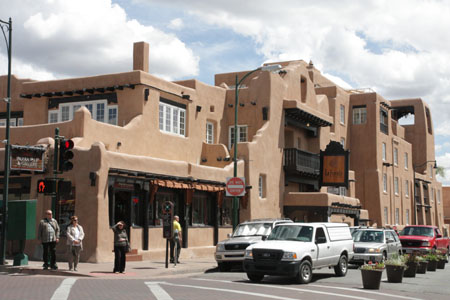 s
with the Adobe buildings in the area, including the Museum of Modern Art
opposite. Next is the
Larotto chapel. It has
been desecrated now and is part of a hotel. It is used for weddings.
Worth seeing is the miracle staircase, which connects the church floor
with the choir. According to legend, they forgot to make a staircase to
the choir. In answer to prayers of the nuns an obscure carpenter came,
who made a spiral staircase, which revolves twice and does not have any
support. The wood is tropical hardwood and that is not common in New
Mexico. How the staircase stays upright is a miracle. According to the
legend the carpenter disappeared without asking for money.
s
with the Adobe buildings in the area, including the Museum of Modern Art
opposite. Next is the
Larotto chapel. It has
been desecrated now and is part of a hotel. It is used for weddings.
Worth seeing is the miracle staircase, which connects the church floor
with the choir. According to legend, they forgot to make a staircase to
the choir. In answer to prayers of the nuns an obscure carpenter came,
who made a spiral staircase, which revolves twice and does not have any
support. The wood is tropical hardwood and that is not common in New
Mexico. How the staircase stays upright is a miracle. According to the
legend the carpenter disappeared without asking for money.
We walk on to the San Miguel mission.
It is said to be the oldest church in the US, built between 1610 and
1625. It is at least the oldest church consistently used as a church.
The church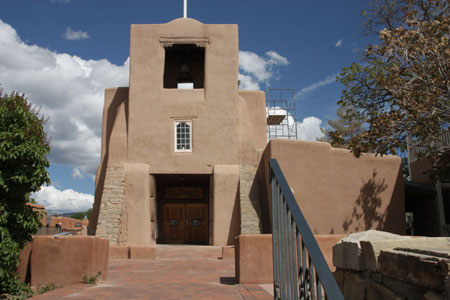 was damaged during the Pueblo revolt, but rebuilt in 1710. The
altarpiece of San Miguel's is from the 18th century (1709) and brought
by the Spaniards in 1798. The church bell at the entrance is Spanish and
was cast in 1356 in Spain.
was damaged during the Pueblo revolt, but rebuilt in 1710. The
altarpiece of San Miguel's is from the 18th century (1709) and brought
by the Spaniards in 1798. The church bell at the entrance is Spanish and
was cast in 1356 in Spain.
We walk back to the car and drive to the hotel. We do some shopping at
Wallmart. Walmart does not sell beer (apparently the law in New Mexico)
and so we have to find a Liquor Store.
At night we eat in the Jambo Café, run by a Kenyan from an island in the Indian Ocean. He has developed his own style of African and Caribean dishes. He stops by our table for a chat and shows he knows the Netherlands and some Dutch words. He advises us not to travel to Kenya because of the unstable situation there. President Kenyatta even stood trial in The Hague he points out.
Weather: sunny, 20°C
Wednesday 27 May 2015
Breakfast at the El Rey inn is rather modest, but it's doable. We get
a tortilla with it, which is rather dry. After breakfast we drive to
Downtown Subscription, a coffee shop and newsstand in an affluent
neighborhood of Santa Fe. This is where the local intelligentsia gathers to drink coffee and
buy a copy of the New Yorker or Harper's. They even sell Le Monde and
the Guardian.
Fe. This is where the local intelligentsia gathers to drink coffee and
buy a copy of the New Yorker or Harper's. They even sell Le Monde and
the Guardian.
After coffee we walk along the Canyon Drive eastbound. Here the art
galleries string along the road. There are dozens in this leafy setting.
Quite a few also have a sculpture garden, where the merchandise is
displayed. Very special. We drive to the end of the Drive to the Christo
Rey Church. This is the largest adobe structure in the US. The church
was built in 1939 in the famous Adobe revival style. Even the altarpiece
and the calvary are done in that style.
Then we drive to the Museum Hill. We soon find ourselves beyond the city
limits - Santa Fe is really a small town - and get there right before
the museums open. It's really a hill. In the distance we have a view of
the old city. We first drink coffee 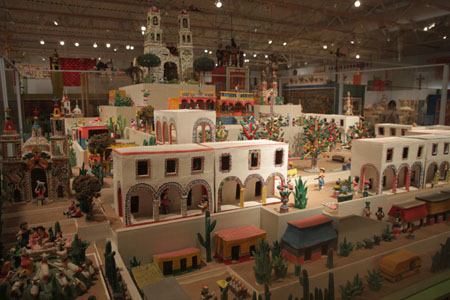 on
a terrace in the sun and then visit the
Museum of
International Folk Art. A beautifully designed museum with
changing exhibitions. The first room is dedicated to contemporary
pottery from South Carolina. Then followed by two rooms dedicated to use
of cochinel red. The Netherlands get a brief mention. A Dutch researcher
found out in the 17th century that the cochinel was an insect. These
animals apparently produce a bright red dye. We see many rugs, ponchos,
paintings and even a red chair that was used by Napoleon. The last room
is a large hall with dollhouses and minature houses and towns. Most in
South American style.
on
a terrace in the sun and then visit the
Museum of
International Folk Art. A beautifully designed museum with
changing exhibitions. The first room is dedicated to contemporary
pottery from South Carolina. Then followed by two rooms dedicated to use
of cochinel red. The Netherlands get a brief mention. A Dutch researcher
found out in the 17th century that the cochinel was an insect. These
animals apparently produce a bright red dye. We see many rugs, ponchos,
paintings and even a red chair that was used by Napoleon. The last room
is a large hall with dollhouses and minature houses and towns. Most in
South American style.
After the museum we drive into the center and go to the La Fonda hotel
to have lunch on the roof top terrace. This is called the Bell Tower
café. It is still closed, but we're in the elevator with the bar's
manager and he immediately rounds up staff so we can sit on the terrace
and order something. The menu consists solely of quesedillas, but they
done quite well. The view of the town in the sun is very pleasant.
After lunch we drive to Los Alamos. That is the location where in World
War II the Ma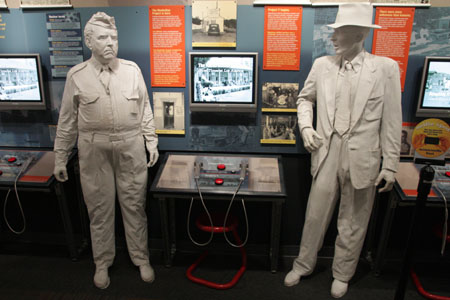 nhattan
Project had its home base. The project was aimed to develop the atomic
bomb to decide the war in favor of the Allies. We visit the Bradbury
Science museum with a nice exhibition on nuclear research at Los
Alamos. Most interesting is the historical section of the exhibition on
the Manhattan Project. There is also a film. Much attention to Robert
Oppenheimer, the scientific leader of the project and Air Force General
Groves, who's job was to manage the project to a military purpose. The
success of the project is the production of the two atomic bombs and the
end of the war. Not much attentions is paid to the destruction and
misery that was caused by the bomb in Japan. It is mainly seen as a
bringer of peace. Survivors of the Japanese occupation in East Asia will
probably agree. There is a wing on present day defense: here attention
is paid to keeping nuclear knowledge and the aging weapons arsenal
up-to-date. Finally the museum focuses on other uses of nuclear
technology, such as healthcare and energy. It's an interesting place.
nhattan
Project had its home base. The project was aimed to develop the atomic
bomb to decide the war in favor of the Allies. We visit the Bradbury
Science museum with a nice exhibition on nuclear research at Los
Alamos. Most interesting is the historical section of the exhibition on
the Manhattan Project. There is also a film. Much attention to Robert
Oppenheimer, the scientific leader of the project and Air Force General
Groves, who's job was to manage the project to a military purpose. The
success of the project is the production of the two atomic bombs and the
end of the war. Not much attentions is paid to the destruction and
misery that was caused by the bomb in Japan. It is mainly seen as a
bringer of peace. Survivors of the Japanese occupation in East Asia will
probably agree. There is a wing on present day defense: here attention
is paid to keeping nuclear knowledge and the aging weapons arsenal
up-to-date. Finally the museum focuses on other uses of nuclear
technology, such as healthcare and energy. It's an interesting place.  I
ask the staff if there are any buildings left over from the days of the
Manhattan Project. There are. In particular, Fuller House. This was a
boarding school for ailing boys in the mountains until the place was
requisitioned by the Manhattan Project. The school had to close and
scientists moved in. Also near is Bath Tub Row. That's a street with
houses from that period, where the most important scientists like
Oppenheimer and Teller lived. These houses had the luxury of a bath. The
other staff members had less luxurious lodgings. The reason why the
project came right here was due to Robert Oppenheimer. Once Albert
Einstein had convinced the president of the need to concentrate and
accelerate the research for a nuclear bomb, Oppenheimer got the
scientific leadership. The project needed a secluded location, yet with
a minimum of amenities. Oppenheimer knew this region from the time he
was recovering from Tuberculosis. He suggested settle the project here.
The tests were conducted in Nevada in the desert. After visiting the
museum we have a drink at Starbucks in Los Alamos and then drive back to
the hotel.
I
ask the staff if there are any buildings left over from the days of the
Manhattan Project. There are. In particular, Fuller House. This was a
boarding school for ailing boys in the mountains until the place was
requisitioned by the Manhattan Project. The school had to close and
scientists moved in. Also near is Bath Tub Row. That's a street with
houses from that period, where the most important scientists like
Oppenheimer and Teller lived. These houses had the luxury of a bath. The
other staff members had less luxurious lodgings. The reason why the
project came right here was due to Robert Oppenheimer. Once Albert
Einstein had convinced the president of the need to concentrate and
accelerate the research for a nuclear bomb, Oppenheimer got the
scientific leadership. The project needed a secluded location, yet with
a minimum of amenities. Oppenheimer knew this region from the time he
was recovering from Tuberculosis. He suggested settle the project here.
The tests were conducted in Nevada in the desert. After visiting the
museum we have a drink at Starbucks in Los Alamos and then drive back to
the hotel.
At 5pm we go to the Blue Rooster, the local gay bar. Apart from the
barmaid the place is totally dead. We eat at Il
Piatto in downtown Santa Fe. Delicious food and normal portions.
I have a salad and duck breast. Erik salmon carpaccio and pasta. Hot
Bread Cake and Cheesecake as dessert. We sit at a table by the window
and are surprised when we suddenly see Thijs (from Taos) his wife waking
up to the restaurant. They recognize us and greet us enthusiatically.
They also eat here.
Weather: Sunny 25°C
Thursday 28 May 2015
After breakfast we have coffee again in Downtown Subscription. After
that, we  drive
to Albuquerque. It's only an hour away. We arrive around 10.30am. We
have received the right codes for the door and the alarm to the house we
booked through
Airbnb. It is
located in a quiet residential area near the Old Town. We get settled
and rest a bit. Then we go shopping for groceries in the neighborhood
Lowe's store. A large shop
with a wide choice of (expensive) organic foods, but fortunately also
regular food.
drive
to Albuquerque. It's only an hour away. We arrive around 10.30am. We
have received the right codes for the door and the alarm to the house we
booked through
Airbnb. It is
located in a quiet residential area near the Old Town. We get settled
and rest a bit. Then we go shopping for groceries in the neighborhood
Lowe's store. A large shop
with a wide choice of (expensive) organic foods, but fortunately also
regular food.
Then we drive to Old Town. That is around the Plaza. On the north side
stands the church, which has been in continuous use since 1709 . On the
inside the church is simple and a bit disappointing. The streets around
the plaza filled with art, antique and souvenir shops and restaurants.
It's very touristy. We drive to the
Aquarium in
the ABQ Bio park on the banks of the Rio Grande. The aquarium
has a lot of rays and sharks that swim in the large pool that can also
be admired from the cafeteria. There is also a tunnel where you can walk
between the fish.
We drive back to the house. We eat a sushi at night in our house. The sushi we bought from the supermarket. Later we drink coffee at the Golden Crown panaderia on Mountain St.
Weather: sunny and 26°C
Friday 29 May 2015
We have break fast
in our cottage. After breakfast we have coffee at the coffee shop two
doors down on our street, the
Boiler Monkey.
We drive to the
Sandia Mountain Tramway.
This is a cable car that leads to the top of the Sandia Mountain. The
cable car was started by a ski enthusiast in Albuquerque, who wanted to
open up the mountain for skiers. We go up for the view of the city and
surroundings. We enjoy the view. After walking around a bit we take the
return trip down. We drive from the ground station via the Tramway
Boulevard to Central Avenue. This street is part of the historic Route
66, the highway from Chicago to Los Angeles. The route
was established in 1926 and has become an icon in American culture. It
was the route for people from the mid-west, which fled the Dust Bowl in
the 1930s towards the coast. Later in the 1960s it became a phen
fast
in our cottage. After breakfast we have coffee at the coffee shop two
doors down on our street, the
Boiler Monkey.
We drive to the
Sandia Mountain Tramway.
This is a cable car that leads to the top of the Sandia Mountain. The
cable car was started by a ski enthusiast in Albuquerque, who wanted to
open up the mountain for skiers. We go up for the view of the city and
surroundings. We enjoy the view. After walking around a bit we take the
return trip down. We drive from the ground station via the Tramway
Boulevard to Central Avenue. This street is part of the historic Route
66, the highway from Chicago to Los Angeles. The route
was established in 1926 and has become an icon in American culture. It
was the route for people from the mid-west, which fled the Dust Bowl in
the 1930s towards the coast. Later in the 1960s it became a phen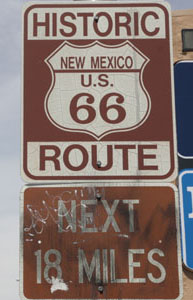 omenon
in American culture with the trek to the California coast where the
1960s youth flourished,
omenon
in American culture with the trek to the California coast where the
1960s youth flourished, especially after the hit "Get your kicks on Route 66". The route is
officially no longer as US highway, after it was replaced by the
Interstate System of highways. The route still appeals to the
imagination. Many towns, cities and communities do their best to keep
the nostalgia around the route alive. The goes for Albuquerque too.
Along the street are many motels, hotels, bars and restaurants that have
been kept going or revived to keep the romance of the road alive. We
stop at the
diner 66, built in Art Deco
style is conserved or built entirely in its original style. We go t
especially after the hit "Get your kicks on Route 66". The route is
officially no longer as US highway, after it was replaced by the
Interstate System of highways. The route still appeals to the
imagination. Many towns, cities and communities do their best to keep
the nostalgia around the route alive. The goes for Albuquerque too.
Along the street are many motels, hotels, bars and restaurants that have
been kept going or revived to keep the romance of the road alive. We
stop at the
diner 66, built in Art Deco
style is conserved or built entirely in its original style. We go t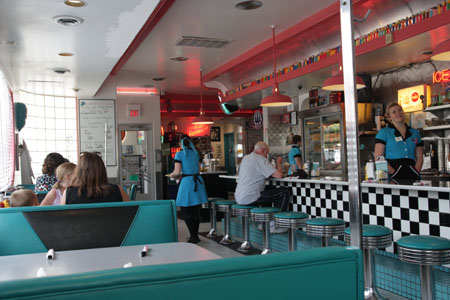 here
for lunch. Our burger is rich with fries. The staff are donning 1950s
style uniforms and the bar has museum value.
here
for lunch. Our burger is rich with fries. The staff are donning 1950s
style uniforms and the bar has museum value.
At night we eat at
Cocina Azul, where they
serve New Mexican fare in a diner-like setting. The waitstaff is
friendly and smooth, but with a keen eye on commerce. After dinner we
drink coffee at the Golden Crown Panaderia.
Later in the evening we drive to the Hotel Parq Central. On the roof is
the
Apothecary Lounge bar. The hotel is a former psychiatric
hospital. The roof terrace is great. Beautiful views from comfortable
lounge sofas and delicious cocktails. The evening breeze on the roof
makes it complete.
Weather: sunny, 25°C
Saturday 30 May 2015
After breakfast we have coffee at the Boiler Monkey. Then we drive to
the Albuquerque airport . The retrun point for car rentals is still a
long way from the airport building. We drop off the Chrysler 200 after 4
weeks' service at Hertz and take the shuttle bus to the terminal. We
check in and await the departure of our flight to Minneapolis-St Paul in
Minnesota. We leave at 2:35pm and arrive around 6pm. We eat in a fast
food restaurant, waiting for our flight to Amsterdam. All seats in the
waiting room have a tablet computer which you can use to view
information, but also to order something. Very modern. We leave on time
and after 12 hours we arrive in Amsterdam at 10.40am. From there we take
the Intercity train to Rotterdam, because the IC Direct is out of
service because of maintenance.
We are home
Rond 12 uur zijn we
thuis.
|
|
Andere Reisverslagen | |
| terug |